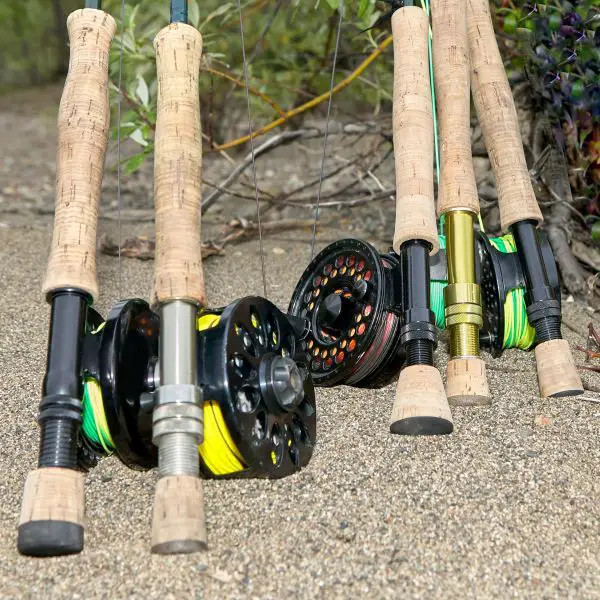Fly fishing reels range in price from around $20 at the low end, to around $2500 for a high end Abel, some limited edition hardy reels are more expensive still. But just how much does someone need to spend to get a fly reel up to the task of landing trout?
I have been fly fishing for close to 20 years, with thousands of hours spent on the river. I have yet to lose a fish because my fly reel was inadequate or poorly made. For trout and most similar size fish, a fly reel is a container that holds the line. Unless abused, very little actually goes wrong with them so for this reason, almost every fly reel is adequate for trout fishing.
Let’s discuss price brackets.
It is safe to say, that all fly reels exceeding $1000 in price are more collector pieces or works of art. While they are certainly lovely reels, people buy them more for the cosmetic and underlying story than any perceived functionality. Some even come hand painted or in limited numbers.
Coming back down to earth, any freshwater reels costing in excess of $300 still ends up in this category. Yes, most reels in the $300+ price bracket are excellent and usually, very stylish and precisely machined out of premium quality materials with minimal gaps to trap stray tippet. In this price bracket expect all fly reels to be machined and assembled in a developed country. The majority of them are from South Korea, but a few are still made/assembled in the west. There is nothing wrong with a South Korean made fly reel.
Other than warranty and better after sales support, one advantage of buying a premium fly reel from a reputable and established brand is that they tend to hold onto their resale value quite well. A few even become collector items. Now, I am not suggesting expensive fly fishing reels as an investment, they are not, but they are not always money down the drain.
The role of a fly reel in trout fishing?
The fly reel plays one important role, as a container to hold and control the line. When fly fishing for trout, the drag is rarely required and people have been successfully landing salmon and steelheads on dragless click and pawl reels for years.
Compared with conventional reels, fly reels do very little work and are remarkably basic. They do not have to eliminate line twist by smoothly and universally laying even the thinnest of lines on a spool. Inside a spinning reel, not counting the drag there are about 20 moving parts that need to work in harmony. In contrast, a fly reel (not including the drag washers) has two moving parts, the spool and handle. There is very little that can and does go wrong.
One way to look at it, Shimano sells their extremely refined, and precisely machined Stradic trout spinning reel for under $200, a reel which is many orders of magnitudes more complicated than even the best fly reels. This just shows how much of a premium some fly reel manufacturers are charging.
Where is the price sweet spot?
I like nice things, so I personally like to use the Lamson Guru line of fly reels as a benchmark for quality. At the time of writing, they retail for around $290.00 but I usually wait until they are on clearance before buying one.
Lamson reels are machined in the United States, and from my own experience know they are extremely smooth and durable, I have had zero issues with the steeled drag, it is strong and consistently smooth. I do not have a bad word to say about these reels, but I accept that others complain about flexibility in the design and too large of a gap between the spool and frame and some people even managed to seize them up after use in the salt. Issues, I have never faced.
(Want to know how well a Lamson guru holds up after a decade of use, check this article)
But, is it a better reel than say an Orvis Battenkill at $130 for the click and pawl or $180 for the disc drag? Well, quite simply no. Both reels are perfectly up to the task of landing trout and perform very well. Doubling the retail price certainly does not get a much better reel for trout fishing. The main difference might just be in the country of origin, the Battenkill is made in China while the Guru line is from the States.
Many people can not, or are not prepared to spend over $100 for a fly reel. After-all that is a lot of money to spend on what amounts to little more than a line holder. $100 is also twice the cost of some very good quality spinning reels. So there is not really any excuse for a bad fly reel in this price range.
And, for the most part, there are some very nice reels to be had, but first, you will need to decide between a machined reel from a Chinese manufacturer or a die-cast reel from an established brand.
For die-cast reels the Echo Ion, Orvis Clearwater, or the Redington Run spring to mind, although the run has crept up in price a bit lately. The main downside to die-cast reels is that they are slightly less impact resistant. They can crack if you drop them onto rocks. But, these reels are still fine for trout fishing.
Lastly, we have the Chinese machined reels, such as Maxcatch, and Piscifun. While I have never actually owned one, I have only received positive feedback including from a mate who uses them for saltwater fly. A much more demanding environment than trout fishing. Just do not expect stellar customer support if anything goes wrong.

